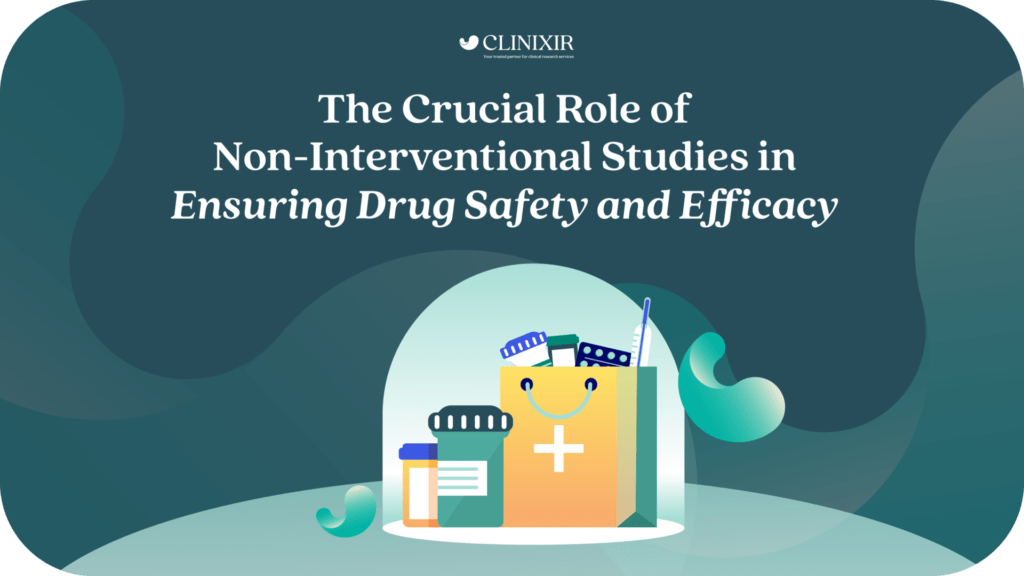Non-interventional studies (NIS), often referred to as observational studies, are essential in assessing the safety and efficacy of drugs outside the rigid and controlled environment of randomized controlled trials (RCTs). While RCTs are the gold standard for determining a drug’s initial safety and effectiveness, NIS plays a crucial role in providing a more comprehensive understanding of how these drugs perform in real-world settings. These studies, including cohort studies, case-control studies, and cross-sectional studies, offer insights into a drug’s performance under normal clinical conditions, thereby contributing significantly to the body of knowledge on drug safety and efficacy.
Contribution to Drug Safety
Real-World Safety Data
One of the most significant contributions of NIS is their ability to gather safety data from a broader and more diverse patient population than RCTs typically include. RCTs often involve carefully selected participants who meet specific inclusion and exclusion criteria, which may limit the generalizability of their findings. In contrast, NIS includes a wide range of individuals, including those with co-morbid conditions or those who are using multiple medications. This broader inclusion helps in identifying rare or long-term adverse effects that might not be apparent in RCTs.
For example, the post-marketing surveillance of the drug Vioxx (rofecoxib) highlights the importance of NIS in drug safety. Vioxx was initially approved based on data from RCTs, which did not reveal significant safety concerns. However, after the drug was widely prescribed, NIS and other observational studies identified an increased risk of cardiovascular events, such as heart attacks and strokes, among its users. This finding led to the withdrawal of Vioxx from the market in 2004. The case of Vioxx underscores the critical role that NIS plays in detecting adverse effects that may only become apparent when a drug is used in a broader population.
Long-Term Safety Monitoring
Another crucial aspect of NIS is their ability to track long-term safety issues that might not be feasible within the relatively short time frame of an RCT. Many chronic side effects or late-onset adverse events emerge only after prolonged use of a drug, making long-term monitoring essential for a complete safety profile.
A prime example is the use of statins, such as atorvastatin, which are widely prescribed to lower cholesterol levels and reduce the risk of cardiovascular events. While RCTs have demonstrated the efficacy of statins in reducing these risks, NIS have been instrumental in evaluating their long-term safety. For instance, studies like the Women’s Health Initiative Observational Study have highlighted an increased incidence of diabetes in women taking statins over extended periods. This finding has led to a more nuanced understanding of the risks and benefits of long-term statin use, allowing healthcare providers to make more informed decisions when prescribing these medications.
Identification of Rare Adverse Events
Certain adverse effects are so rare that they are unlikely to be detected in RCTs due to their limited sample sizes. NIS, with their larger and more varied patient populations, are better suited to reveal these rare events, providing crucial information that can lead to changes in clinical practice and drug labeling.
The association between the use of the antiepileptic drug valproate and an increased risk of birth defects is a notable example. Initial RCTs did not adequately capture this risk, possibly due to the small number of pregnancies included in the studies. However, subsequent observational studies provided critical data showing that valproate significantly increased the risk of neural tube defects and other malformations. This information has since led to revised prescribing guidelines, including stronger warnings about the use of valproate in women of childbearing age.
Contribution to Drug Efficacy
Effectiveness in Routine Clinical Practice
NIS are also invaluable in assessing how well a drug performs in everyday clinical settings, as opposed to the controlled conditions of RCTs. These studies help to understand the drug’s effectiveness in a broader patient population with diverse characteristics and co-existing conditions, which is often more reflective of the general population.
The efficacy of antihypertensive drugs, such as losartan, has been extensively evaluated through NIS. While RCTs have shown losartan’s efficacy in reducing blood pressure and preventing cardiovascular events, observational studies have provided insights into its effectiveness in real-world settings. These studies have confirmed the drug’s benefits in diverse patient groups, supporting its use in routine clinical practice. Moreover, NIS has provided valuable information on how factors such as age, gender, and the presence of other medical conditions can influence the drug’s effectiveness.
Comparison of Therapeutic Strategies
NIS enables comparative effectiveness research, where different treatments can be evaluated against each other in routine clinical practice. This comparison can provide valuable information on which treatments work best for specific populations or conditions, leading to more personalized and effective healthcare.
For example, observational studies comparing different diabetes management strategies have provided evidence on the effectiveness of various drug classes in controlling blood glucose levels and reducing complications. NIS have compared the efficacy of GLP-1 receptor agonists with other antidiabetic medications, contributing to more personalized treatment approaches for diabetes. These studies have helped healthcare providers make more informed decisions about which therapies are most likely to benefit individual patients, based on their unique characteristics and health needs.
Assessment of Drug Adherence and Outcomes
Real-world data on patient adherence to medications and subsequent outcomes are often gathered through NIS. Understanding adherence patterns is crucial for evaluating the practical efficacy of a drug, as non-adherence can significantly impact treatment outcomes.
Research into adherence to medications for chronic diseases such as asthma has highlighted the impact of adherence on treatment outcomes. NIS have shown that better adherence to inhaled corticosteroids correlates with improved asthma control and reduced hospitalizations, emphasizing the importance of patient compliance in therapeutic success. These findings have led to the development of interventions aimed at improving adherence, such as patient education programs and reminder systems, ultimately enhancing the effectiveness of asthma treatment in real-world settings.
Non-interventional studies provide essential contributions to drug safety and efficacy by complementing the data from RCTs. They offer insights into the real-world performance of medications, uncover rare or long-term adverse effects, and demonstrate the effectiveness of drugs in diverse patient populations. The examples discussed, such as the identification of cardiovascular risks associated with Vioxx and the evaluation of statin-related diabetes risks, underscore the importance of NIS in enhancing drug safety. Similarly, studies on antihypertensive drugs and diabetes management strategies illustrate how NIS can inform effective treatment approaches. Collectively, these studies help ensure that drugs not only perform well under ideal conditions but also provide valuable benefits and safety in everyday clinical practice, thereby playing a crucial role in advancing public health.



